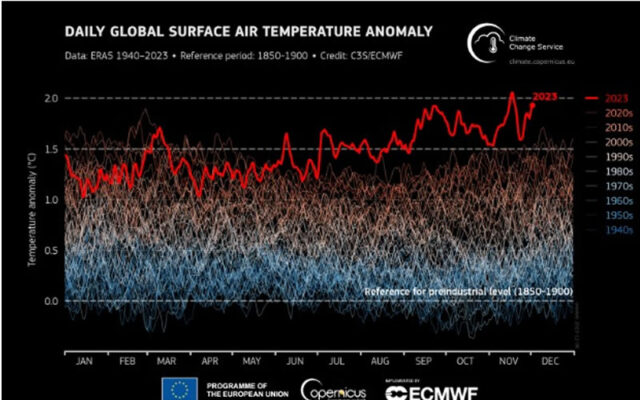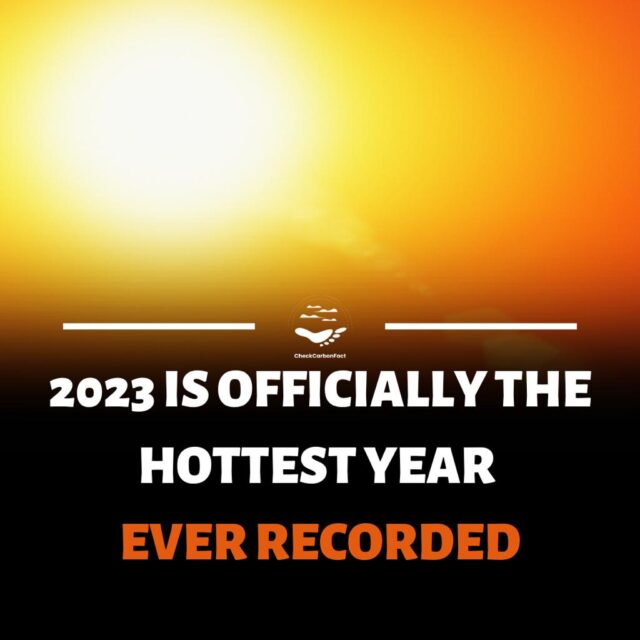The year 2023 has etched its name in history as the hottest ever recorded, surpassing the previous record-holder, 2016. According to scientists, the global average temperature for the year reached 0.13 degrees Celsius higher than the first eleven months of 2016, raising concerns about the escalating climate crisis.
Daily global average surface air temperature anomalies (°C) relative to estimated values for 1850-1900, plotted as time series for each year from Jan. 1, 1940, to Dec. 2, 2023. The year 2023 is shown with a thick red line.

Source: Copernicus Climate Change
The Soaring Temperatures of 2023
The global average temperature for 2023 surged 0.13 degrees Celsius higher than the first eleven months of 2016, sparking concerns among climate scientists worldwide. The Copernicus Climate Change Service of the European Union disclosed that 2023 approached the critical 1.5-degree Celsius threshold outlined in the Paris climate agreement. Breaching this threshold could pose significant challenges for both humanity and ecosystems, necessitating urgent climate interventions.
Remarkably, every month from June 2023 was crowned as the hottest, with November standing out as exceptionally warm—estimated to be 1.75 degrees warmer than pre-industrial levels. The year even witnessed two consecutive days where temperatures exceeded the 2-degree mark, leaving scientists grappling with the uncertain implications of such rapid temperature changes.
To understand the reason behind this record breaking temperature surge, this blog will consider two critical elements.
The Influence of El Niño’s
The influence of El Niño on the unprecedented temperature records of 2023 cannot be overstated. El Niño, an irregular climate phenomenon that occurs every 2–7 years, involves the warming of surface and subsurface waters in the eastern and central tropical Pacific Ocean. This warming significantly impacts atmospheric circulation, leading to substantial changes in global climate patterns.
During intense El Niño events, such as those in 1982–83 and 1997–98, sea surface temperatures in the eastern Pacific soared to levels well above normal. The consequences were severe, causing widespread climate disruptions across the globe. In 1982–83, for example, the elevated temperatures led to a harsh drought in Australia, typhoons in Tahiti, and flooding in Chile. Similarly, during the 1997–98 El Niño, drought conditions were experienced in Indonesia, Malaysia, and the Philippines, while Peru faced devastating flooding and California witnessed increased winter rainfall.
The 2015/16 El Niño, which was comparable in intensity to the most significant events of the 20th century, contributed to the global temperature increase recorded in 2016. The Copernicus Climate Change Service reported that 2016 was nearly 0.2°C warmer than 2015 and approximately 1.3°C warmer than pre-industrial levels.
In the context of 2023, experts suggest that the El Niño event might persist beyond February 2024, potentially extending into April. While El Niño is a significant contributor to temperature variations, it is crucial to recognise that it is not the sole factor influencing climate patterns. Other phenomena, including human activities and natural processes, play interconnected roles in shaping the earth’s climate.

Human Activities and Carbon Emissions As Critical Catalyst for the Climate Crisis
In the intricate tapestry of climate change, the role played by human activities and the resulting carbon emissions emerges as a pivotal and concerning factor. Over the last century, humanity has unwittingly become a driving force behind the unprecedented rise in global temperatures, unleashing a cascade of environmental consequences.
Looking back over the last 100 years, the rate at which humans have released CO2 pollution far surpasses any comparable period in the previous 800,000 years of earth’s history. The planet’s temperature has spiked dramatically in the last 50 years, exceeding any warming trends observed in at least the past 2,000 years. This accelerated warming poses a direct threat to the delicate equilibrium of our planet’s ecosystems.
Fossil Fuel Dependency
At the heart of this climate crisis lies our dependence on fossil fuels—coal, oil, and natural gas—as the primary sources of energy. These fossil fuels have been the lifeblood of industrialization, powering our economies and fueling technological advancements.
However, the unintended consequence has been the relentless release of carbon dioxide and nitrous oxide into the atmosphere, creating a thick blanket of heat-trapping pollutants.
In 2020, fossil fuels accounted for a staggering 85% of all energy used in Ireland alone, underscoring the global scale of the challenge. The reliance on these conventional energy sources, though essential for progress, has unwittingly become a major contributor to the escalating climate crisis.
Everyday Activities and Unseen Emissions
Beyond large-scale industrial activities, seemingly innocuous daily actions also play a role in exacerbating carbon emissions. Whether it’s sending an email, streaming a movie, or conducting an online search, each digital interaction contributes, albeit minutely, to the carbon footprint.
While individually these actions may seem negligible, cumulatively they constitute a significant portion of the 3.7% of global greenhouse gas emissions attributed to such routine digital activities.
Understanding the pervasive nature of these emissions is crucial for fostering awareness among the general population. It emphasizes the need for a collective shift in behaviour and a transition towards more sustainable practices in both the individual and corporate spheres.
The Imperative for Change: What Can Be Done?
The imperative to address the escalating climate crisis necessitates a multifaceted approach, involving swift transitions to clean energy, raising awareness about sustainable lifestyles, and implementing policy changes.
Governments and industries must invest in renewable energy sources, promote eco-friendly practices, and enact and enforce policies regulating carbon emissions. International collaboration is crucial to developing comprehensive global policies, and fostering research and innovation in green technologies is key to driving economic growth while mitigating environmental impact.
In addition to these efforts, adapting to climate change requires investing in resilience measures such as infrastructure capable of withstanding extreme weather events and water conservation strategies. Furthermore, embracing circular economy practices, minimising waste, and recycling extensively are essential for a sustainable future.
The Time to Act is Now
The future remains uncertain, with scientists unable to predict the upcoming years’ climate patterns accurately. However, there is a greater than 50% chance that the earth’s global temperature will surpass 1.5 degrees Celsius by the end of 2028, heightening the risk of triggering irreversible climate tipping points.
As we stand at this crossroads of a climate crisis, international collaboration, commitment to sustainable practices, and a collective effort are the need of the hour. Adapting to these changes will require a combination of mitigation efforts and strategies to live with and adapt to the impacts already set in motion. The combination of strategies, coupled with innovation in green technologies, will provide a promising path forward in our collective fight against climate change. The time to act is now, and with concerted efforts, we can pave the way towards a more sustainable and resilient future for generations to come.
Found it interesting and would like more in the mail?




